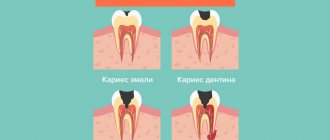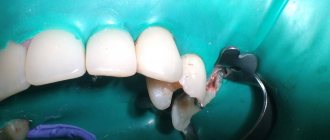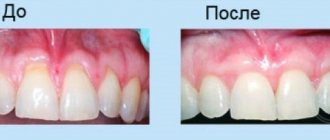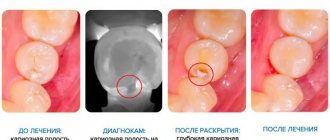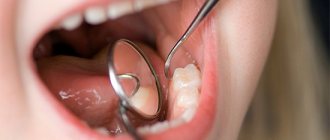Symptoms of caries
Diagnosis of the disease should only be carried out in the dentist's office. But the person himself can determine the presence of this pathology by very characteristic symptoms:
- the appearance of dark spots on the teeth: most often they appear on the chewing surface, but often inflammation develops between the teeth (but it is usually not possible for the patient to see this - special equipment will be required),
- there is a roughness of the surface of the teeth,
- When eating food, aching pain appears, teeth react to sweet and sour, as well as cold and hot. But the unpleasant sensations subside immediately as soon as contact with the irritant ceases - this is how caries, even deep ones, differs from pulpitis - inflammation of the dental nerve,
- Breath odor may become unpleasant,
- a carious cavity can even be felt with the tongue; food debris often gets clogged into it, which causes discomfort or even swelling of the tooth - for example, if a small gap appears under a filling.
Dental caries:
To exclude pulpitis, a thorough curettage of the periodontal pocket is carried out and hygienic measures in the oral cavity are recommended. The cessation of pain after curettage, which most often happens in the presence of a slit-like gap, confirms the diagnosis of inflammation of the gingival papilla - papillitis. If pulpitis is suspected, the reaction of the pulp to cold and hot is determined by EDI. —Treatment is reduced to removing the previously applied filling and filling using a contour matrix, which ensures the creation of a contact point at the equator level. In some cases, it becomes necessary to replace seals on two contacting surfaces. A prerequisite for successful treatment is the correct fixation of the matrix using a wedge, which should be inserted between the teeth with force, which ensures displacement of the tooth by the thickness of the matrix.
In the case of tooth displacement and an increase in the interdental space, it is not possible to create full contact. In such cases, the anatomical shape of the tooth is restored, leaving an interdental gap of significant size, which eliminates the possibility of food retention.
10. Overhanging edge of the filling.
This is a common mistake when filling, which occurs when the matrix is applied incorrectly, if the wedge does not press the matrix tightly to the tooth surface or is not used at all to fix the matrix. However, most often an overhanging edge of the filling occurs, sometimes occupying the entire interdental space, when not a matrix and matrix holder are used, but a metal plate. Unfortunately, even today there is one filling on two adjacent teeth.
When filling a class II cavity, a matrix must be used, and its lower edge must be tightly pressed with a wedge to the surface of the tooth being filled. The use of a metal strip (not a matrix) may be indicated if the class II carious cavity is small in size and located at the level of the equator, as well as with buccal access to the carious cavity, which is discussed earlier.
11. Loss of a filling immediately or a short time after its application
. This may be a consequence of a number of factors: violation of the principles of preparation, incorrect choice of filling material, violation of filling technology. One of the most likely reasons is insufficient drying or incomplete polymerization of the material. In this regard, it is necessary to pay attention to isolation from saliva and control of the power of the polymerization lamp.
12. Pain after filling
may arise for a number of reasons. First of all, this may be a consequence of preparation without sufficient water cooling. Pain is also possible if an insulating lining made of glass ionomer cement is applied and filled with a composite on the same day. This is explained by the different polymerization times of GIC (within 24 hours) and the composite, which may result in displacement of the gasket.
13. Pulp necrosis after filling.
Currently, filling materials (Evicrol, Consize), which have an irritating effect on the pulp, are practically not used. In addition, real adhesive systems practically eliminate the possibility of this action, but this should be kept in mind. In addition, pulp necrosis is possible due to cavity preparation without cooling.
14. Excessive removal of the composite into the gingival groove
accompanied by inflammation - hyperemia and bleeding. In addition, this is one of the reasons for the accelerated partial or complete loss of the restoration. The presence of a step at the tooth tissue-composite interface indicates the need for careful grinding and polishing. For this purpose, fine-grained diamond polishers or carbide burs are used. The criterion for quality work is the imperceptible transition of the probe from the surface of the restoration to the tooth.
15. Stability of tooth color after restoration (filling).
Previously used composites (Evicrol, Consize, etc.) did not guarantee the stability of the color of the restoration. Moreover, over time, after 2-4 years, a change in color was usually noted. A yellowish tint appeared, gloss was lost, etc. Currently produced composites practically do not change color. Therefore, a change in the color of the restoration indicates errors during filling. First of all, this is due to the wrong choice of the color scheme of the filling material or the non-use of opaque. Due to the fact that the color of a tooth with high transparency of the enamel is determined by the thickness of the dentin layer, during restoration it should be based on an opaque layer. If this provision is violated, based on the presented premise, the following errors may occur.
15.1. Wrong choice of restoration color.
15.2. Highlighting the restoration area (whitish tint) with the correct choice of tooth color. This is due to the fact that the base of the filling is not made of opaque (the color of dentin), which determines the color of the tooth.
15.3. Identification of the contours of the sealed cavity. This occurs in the absence of a bevel of the enamel, which does not ensure a gradual transition of the tooth color to the color of the restoration.
15.4. The presence of an altered area with full color matching of the main surface of the restoration is due to either insufficient excision of the altered tissues, or covering the altered dentin layer with a thin layer of opaque, or refusal to use opaque.
15.5. The appearance of whitish “veins” on the surface of the restoration. The reason is insufficient condensation of the newly applied composite layer, as a result of which there is no close contact between the previously cured layer and the newly applied one. To eliminate these shortcomings in the selection of the color of the restoration, it is recommended to carry out partial or complete removal of the restoration and repeat it.
16. Filling of premolars and molars without the formation of tubercles and fissures of the chewing surface.
The consequence of this may be a change in the bite. In this case, it is recommended to carry out a new restoration.
Reasons for the development of the carious process
The development of caries largely depends on the individual characteristics of the body. For example, in women with hormonal imbalances, plaque accumulates on the teeth more often, which leads to an increased attack from bacteria. In general, caries is caused by pathological microorganisms, which become much more numerous in the oral cavity than good bacteria. And their appearance is caused by the following reasons:
- lack of proper hygiene: brushing your teeth for 20-30 seconds in the morning and evening is very little. Dentists' recommendations are at least 2 minutes twice a day, as well as removing food debris that accumulates in narrow spaces after eating. Gradually they transform into plaque, which is a provocateur of many dental diseases, including caries,
- poor nutrition: excessive consumption of sweet foods and changes in the PH composition of saliva - all this again contributes to the formation of plaque and an increased attack of bacteria,
- age: it has been established that the destructive processes of primary teeth actively develop in the first years of children’s lives. As you get older, the likelihood of developing dental diseases decreases. This is influenced by the fact that adults pay more attention to oral hygiene. In old age, the risk of caries increases again - this is the result of various diseases of the body and insufficient oral hygiene,
- pregnancy and lactation, that is, during those periods when a woman loses many vitamins and minerals, in particular calcium and fluoride,
- lack of vitamins and, as a result, increased fragility of tooth enamel,
- genetics: a predisposition to many diseases of the gums and teeth is passed on from parents.
Treatment methods
Cure caries, especially at the initial stage, is not difficult - this involves removing the inflamed tissue and then filling it. In the presence of deep lesions, binoculars and a microscope can be used, which allow you to increase the working space and remove even the smallest inflamed cells, while preserving healthy tissue. Depending on the situation, it may also be necessary to restore the coronal part if it has been severely damaged.
Fissure sealing A method that allows you to stop the carious process. Essentially, this is the prevention of inflammation. Fissures or depressions (grooves) on the surface of the enamel are filled with a special sealant, which evens them out and thereby prevents the accumulation of bacteria and plaque.
Price:
from 2500 rubles more details about the solution
Treatment of caries If the doctor notes caries at the spot stage, then the main procedure is remineralization (restoration of the required mineral content) using a special solution. If the caries is superficial, medium or deep, then the resulting cavity will need to be treated, followed by filling using composite materials. When the carious process penetrates into the deep layers, it is advisable to use medicated pads containing calcium hydroxide - this way additional protection is created to preserve the dental nerve.
Price:
2500 rubles more details about the solution
Installing an inlay In a number of situations, when the tooth is quite badly damaged and a large filling will not hold, you can develop an individual inlay made of ceramic or zirconium dioxide. It will accurately follow all the curves of the tooth and be securely fixed inside the cavity. At the same time, it will last many times longer than a large filling.
Price:
from 20,000 rubles more about the solution
Types of incorrect treatment
When the diagnosis has been carried out according to all the rules and the cause and accompanying aspects of the disease have been identified, errors may also occur during the treatment process:
- incomplete preparation of the affected area;
- destruction of the bottom of the cavity affected by caries;
- destruction of the tooth wall in the process of eliminating caries;
- damage to adjacent teeth by a drill;
- damage to the integrity of the gums;
- improper filling;
- incorrectly installed insulation gaskets;
- overestimation of the bite level during filling installation;
- unidentified contact point;
- overhanging edges of the installed filling.
All these mistakes can lead to the development and aggravation of the patient’s oral cavity condition. You can avoid them by turning to trusted, highly qualified specialists. They are the ones who will carry out all the necessary procedures, observing all the rules and standards of quality control.
